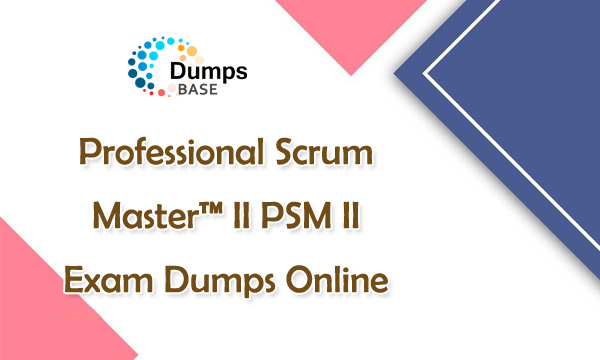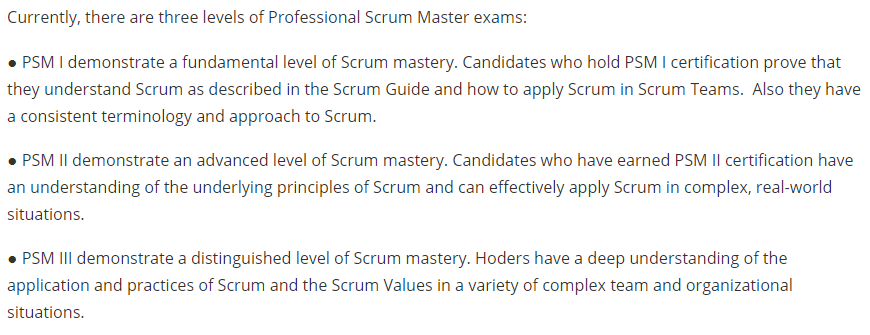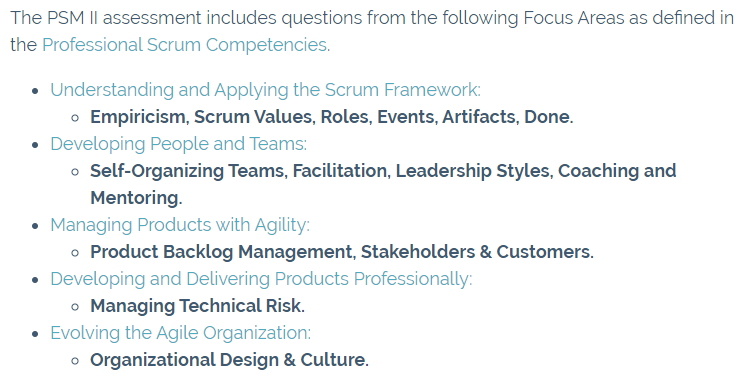Professional Scrum Master™ II PSM II Real Exam Dumps Released
Last November, we introduced PSM I Professional Scrum Master I exam dumps, including the PSM I exam details, Scrum certification exam information and so on. Today, let's go on for the PSM II real exam dumps for your Professional Scrum Master™ II certification exam. Scrum PSM II real exam dumps released at DumpsBase, which will be your great preparation materials for 100% passing Professional Scrum Master™ II certification exam. Accurate PSM II exam questions and answers in PSM II real exam dumps have been verified by the great team, you will have great experience with DumpsBase PSM II certification exam dumps. We ensure that you can pass PSM II Professional Scrum Master™ II certification exam successfully.

PSM Professional Scrum Master Certification Has Three Levels, Including PSM I, PSM II and PSM III
PSM Professional Scrum Master certification is a globally recognized certification to validate that holders have the skills, knowledge, and experience to excel in the role of Scrum Master. PSM Certification is made up of three levels, including PSM I, PSM II and PSM III.

PSM I certification exam is for candidates who wish to demonstrate a fundamental level of Scrum mastery.
PSM II certification exam is for candidateswho wish to prove their underlying knowledge of Scrum principles and show that they can apply these in the real world.
PSM III certification exam is for candidates who hold a deep understanding of Scrum practices and can apply them in a variety of complex organizational settings.
Go On For PSM II Certification After Completed PSM I Certification Exam
Today, we are focusing on PSM I and PSM II certifications because they are the most common and popular. According to the study, there are nearly 200,000 PSM I holders and the number continues to grow. And most of the PSM I holders go on for the PSM II certification assessment. PSM II Professional Scrum Master™ II certification exam of today is simply the old Professional Scrum Practitioner Exam. It is to find whether the candidate is able to apply Scrum to resolve advanced and complex problems of the real world.
To pass PSM II certification exam, candidates have to get a 85% score or higher on a 30 multiple choice (and multiple answer) question test within 90 minutes. Scrum PSM II exam has same subject matter and exam objectives as that of the PSM I.

However, there are core differences between PSM I and PSM II. PSM I is perfect for people who want to understand the basics of Scrum thoroughly. PSM I focuses more on textbook type questions, which test your ability to understand the Scrum guide and the concepts of applying Scrum. It gives you the fundamentals in a way that you can evidence and use.
And, PSM II is the next step for people who want to take it further, which focuses more on real-life situational questions. It goes beyond being able to evidence that you understand Scrum, and shows that you can use it in the workplace. PSM II holders have a deep knowledge and understanding of the Scrum principles and processes. They understand what sits behind the Scrum framework. And they can apply it all in a complex business context to help drive delivery.
Get PSM II Real Exam Dumps To Pass Professional Scrum Master™ II Certification With 100% Passing Guarantee
Professional Scrum Master™ II PSM II Real Exam Dumps released at DumpsBase to help you prepare and practice for PSM II certification exam. Get the latest PSM II study exam dumps to practice all exam questions and answers for Professional Scrum Master™ II certification exam. We ensure that you can pass PSM II certification exam with 100% passing guarantee. More, we highly recommend you to check PSM II free dumps first.
Professional Scrum Master™ II PSM II Free Dumps Online
A Scrum Master is not only a servant-leader to the Scrum Team and organization, it’s also considered a management position.
Which three activities describe what a Scrum Master manages as reflected by the Scrum Guide? (Choose three.)
A. Reporting on the performance of the Sprint.
B. The way Scrum is understood and enacted within the organization.
C. Managing the capacity and utilization of each Development Team member.
D. Managing the process in which Scrum is applied.
E. Managing the Product Backlog items and work in the Sprint Backlog.
F. Removing organizational impediments that limits the team’s progress and productivity.
Answer: BDF
An organization has just hired you as a new Scrum Master to help them transition their teams from their current traditional process to Scrum. The teams are currently structured to specialize in a single function. This is also known as component teams where a team would only address a single layer (i.e. design, frontend, backend, database, testing, etc.). You’ve introduced the concept of cross-functional teams where all the skills needed to produce business functionality, from end to end, are inside of a single team.
What should you keep in mind when transitioning from siloed teams to cross-functional teams? (Choose two.)
A. It is easier to compare the performance between cross-functional teams in order to identify to which teams to assign tasks and which teams need additional coaching.
B. Newly formed teams will need time to stabilize before reaching their peak performance. During the initial stages of forming, performance will suffer and productivity may be low, although even then delivery of business value is still likely to increase.
C. Without feature teams, you cannot do Scrum. Postpone Scrum adoption until the teams are reorganized in feature teams.
D. People from the different layers and components will need time to become accustomed to working and delivering unified functionality together as one Scrum Team thus productivity may suffer.
Answer: BD
Paul is a Product Owner for multiple products. Each product is allocated a dedicated Scrum Team and a set budget. Based on the average velocity of a previous product release, Paul had estimated a new product to take 9 Sprints to complete. The average velocity of the previous product release was 50 completed units of work per Sprint. Over the first 3 Sprints, the Development Team reported an average velocity of 40 completed units per Sprint, while not fully completing the required integration tests. The Development Team estimates that integration testing would require additional effort to make the increments shippable. The Development Team is unsure if the required velocity is achievable.
What is the most effective way to recover?
A. In the next Sprints, the Development Team strives to make the selected work as close to ‘done’ as possible and at the minimum 90% completed. Any undone work is divided into new Product Backlog Items that will be deferred to the last Sprint in order to maintain stable velocity.
B. The Development Team informs Paul that the progress he has perceived to date is not correct. The Increment is not releasable. They give Paul their estimate of the effort it would take to get the previous work ‘done’, and suggest doing that work first before proceeding with new features. The team also re-estimates the effort to make the remaining Product Backlog items ‘done’, including all integration effort. In the end, it is Paul’s call to continue the project or to cancel.
C. The Scrum Master will manage the Sprint Backlog and assign work to the Development Team members to ensure maximum utilization of each member. He/she will keep track of unused resources so that it does not impact the budget. Unused budget can be allocated for additional Sprints if needed.
D. The Scrum Master sets the open work aside to be performed in one or more release Sprints. They remind Paul to find funding for enough Release Sprints in which this remaining work can be done. Up to one release Sprint per three development Sprints may be required. It is Paul’s role to inform users and stakeholders of the impact on the release date.
Answer: B
Paul, a Product Owner of one of the Scrum Teams, has been attending the Daily Scrum. During the Daily Scrum, the Development Team members have been reporting their daily work to Paul so that he is aware of their Sprint progress and what each member is working on.
What is the best action for the Scrum Master to take?
A. Ask Paul to stop attending the Daily Scrum.
B. Coach Paul and Development Team members on the purpose of the Scrum events and let them figure out what to do in this situation.
C. Allow the Paul to participate in the Daily Scrum as he is responsible for the success of the product.
D. Facilitate the Daily Scrums to avoid any conflicts between the Development Team members and Paul.
Answer: B
Steven, the Scrum Master, is approached by one of the Development Team members saying that they are not completing regression tests for all of the work they are performing to the level defined in the Definition of Done. They have discussed this with the Product Owner and decided to remove regression testing from the Definition of Done.
Which two actions are the most appropriate for Steven to take? (Choose two.)
A. Reject the decision as the long term maintainability of the product will be negatively impacted by modifying the Definition of Done.
B. Accept the decision as a mutual agreement has been made between the Development Team and the Product Owner.
C. Ask the Development Team and the Product Owner what problem they are trying to solve by altering the Definition of Done and removing regression testing from it. In what ways will this decision impact transparency and quality?
D. Ask the Development Team and the Product Owner if they are still able to produce potentially shippable product increments by altering the Definition of Done?
Answer: CD
At the end of the eighth Sprint, the internal sponsors are upset and angry with the progress of the product being built. The current state of the product is not as expected and will require additional Sprints and more budget than originally anticipated at the start of the project.
What factors may have led to this? (Choose three.)
A. The Product Owner has not been engaging with sponsors frequently enough and has not been kept aware of the overall progress of the project.
B. The sponsors haven’t been using the Sprint Reviews to actively engage, and inspect and evaluate progress.
C. The scope changes have not been tracked adequately and the change request process has not been followed properly.
D. The stakeholders have not been using the Daily Scrum effectively to track the Development Team’s progress.
E. The Scrum Master has not ensured transparency.
F. The project plan proposed to the sponsors at the start of the project followed stringently.
Answer: ABE
Three Development Teams are currently building a single product and pulling work from the same Product Backlog. All three teams have identified that they will need Dan, a database specialist, to work full time in their team for the next several Sprints.
What should Steven, the Scrum Master, do to solve this potential problem?
A. Manage the items in the Sprint Backlogs so that Dan can be utilized evenly for each team.
B. Assign Dan to the team with the most urgent tasks first and then move him to the next team and so on until the required support is completed.
C. Facilitate a discussion with all Development Teams on how they want to deal with this issue, and help them implement their preferred solution.
D. Ask Dan to work with the HR department to recruit and hire additional database specialists. In the meantime, have the Product Owner move items that do not depend on Dan to the top of the Product Backlog.
Answer: C
An organization wants to apply Scrum to build a new product and has hired Steven to be the Scrum Master of three new teams that will build the first release. The organization is new to Scrum and asks Steven for advice on how to start.
Which two things should Steven first advise? (Choose two.)
A. Each Scrum Team has its own Product Backlog with items only their team will be working on.
B. One Product Backlog to represent all of the known work needed to be done for the product.
C. Three Product Owners, one for each Scrum Team.
D. Having one Product Owner to be accountable for maximizing the flow of value throughout the development process and provide transparency on the overall progress.
Answer: BD
A Development Team has a total of six members, 4 members who work full time in the office and 2 members who work part time at home. The Development Team is complaining that it is too difficult to synchronize every day and has suggested having the Daily Scrum every other day instead.
What would be three key concerns if the Daily Scrum is held less frequently? (Choose three.)
A. Impediments are raised and resolved more slowly.
B. Opportunities to inspect and adapt the Sprint Backlog are reduced.
C. Less information about the progress will be shared causing the Sprint plan to become inaccurate and reducing transparency over progress toward the Sprint Goal.
D. The Scrum Master loses the ability to update the burndown chart adequately.
E. The Product Owner cannot accurately inspect utilization of the individual team members.
Answer: ABC
Steven is a Scrum Master asked to assist in creating five new Scrum Teams that will be working to build a highly anticipated product. He talks with them about the importance of being able to integrate their Increments by the end of their Sprints. This includes the first Sprints. The product is very important to both the end users and the organization.
Of the choices raised by future team members, what would Steven encourage?
A. Each Scrum Team delivers Increments in its own code branch. After UAT is performed at the Sprint Review, the code branch is isolated until enough Increments are considered acceptable. All code branches will then be merged during the release phase.
B. Each Scrum Team delivers functionality at the end of each Sprint. New Product Backlog items will then be added to the next Sprint Backlog to integrate their functionality with the other teams to create a unified Increment.
C. All Scrum Teams agree on a mutual understanding of ‘done’ that defines all work necessary to deliver a potentially shippable Increment that includes all previous Increments delivered for the product.
D. Wait until enough of the infrastructure and architecture is in place before starting the first Sprints. This will increase the success of delivering integrated Increments in Sprint 1.
Answer: C
According to the values of Scrum, which is the best way to create Development Teams?
A. The Product Owner will create a skills matrix according to what is needed for the project and work with the technical leads to allocate resources to the team.
B. Work with the leadership team to allocate members according to skills, seniority and experience to ensure that all Development Teams are balanced fairly.
C. Provide boundaries to the developers and allow them to self-organize into Development Teams.
Answer: C
When multiple Scrum Teams are working from the same Product Backlog, also known as scaled Scrum, they must still work in conformance of the Scrum guide.
A. True
B. False
Answer: A
In Scrum, how would budgeting and financial forecasting be performed? (Choose two.)
A. Frequently inspect the outcomes of the delivered Sprint Increments to understand how much value is being produced per investment spent.
B. A single release may be funded with several Sprints where every Sprint is producing shippable increments.
C. Budgeting is not necessary as the only funding necessary is the operational costs of the Scrum Teams.
D. Fixed budgets are not allowed in Scrum.
Answer: AB
Steven is a Scrum Master that was hired to help an organization, that is new to Scrum, understands and enacts Scrum effectively.
Which three activities would be acceptable? (Choose three.)
A. Require all teams in the organization to start using Scrum as soon as possible.
B. Arrange 1:1 coaching sessions to discuss any identified concerns Steven may have.
C. Schedule formal trainings.
D. Penalize any Scrum Team members who are not staying within the Scrum Framework.
E. Educate stakeholders and clients about Scrum.
F. Extend Retrospectives to include formal training.
Answer: BCE
A Scrum Team has been working on a product for several iterations and has an average velocity of 55 units of ‘done’ work per Sprint. A second team will be added to work on the same product.
What might be the impact on the original team?
A. Their velocity is likely not affected and will remain at 55.
B. Their velocity is likely to drop and be less than 55.
C. Their velocity is likely to rise and be more than 55.
Answer: B
Related PSM I Certification Exam: Updated Professional Scrum Master I PSM I Dumps Questions
